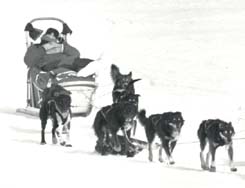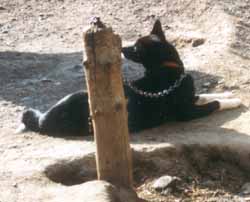Iditarod
Race Facts
The
Iditarod is a dog sled race held every March in Alaska. The
Iditarod begins the first Saturday in March. In this race mushers
(dog sled drivers) force their dogs to run 1,150 miles from
Anchorage to Nome in 8 to 16 days over a grueling terrain. This
is the approximate distance between Los Angeles and Seattle,
New York City and Miami, Chicago and Houston. Mushers press
their dogs to run at ever increasing speeds, so that the dogs
get little rest or sleep. John Baker holds the speed record
for a musher using a GPS-- 8 days, 18 hours, 46 minutes. Martin
Buser holds the speed record for a musher not using a GPS--
8 days, 22 hours and 46 minutes. Both records are Dog’s
beating left me appalled, sick and shocked
(Letter to the Editor, Whitehorse Star,
February 23, 2011) Dog beaten with shovel "I bought one of my dogs from a musher who bragged about beating him with a shovel. The musher's son collaborated* this and was amused by the abuse." *GB
Jones wrote "collaborated" but probably meant to write "corroborated."
Mr. Jones raced in the 2002, 2003, 2004, 2005, 2007, 2008 and
2011 Iditarods. |
||||||||||||
|
|
Facts
| Quotes | Help the
dogs | News | Dog
Care |
Receive action alerts or contact SDAC: [email protected]
PO
Box 562061
Miami, FL 33256
The
SDAC does not raise money and does not accept funds. Its efforts are
completely volunteer-based.
Margery Glickman, Director
© 2013 SDAC

 The
Iditarod is described by the Iditarod Trail Committee and by the
Alaskan media as an exciting contest of man against nature. What
the descriptions do not tell us is the untold suffering of the
dogs that often give their lives in this race. Dog
The
Iditarod is described by the Iditarod Trail Committee and by the
Alaskan media as an exciting contest of man against nature. What
the descriptions do not tell us is the untold suffering of the
dogs that often give their lives in this race. Dog 
